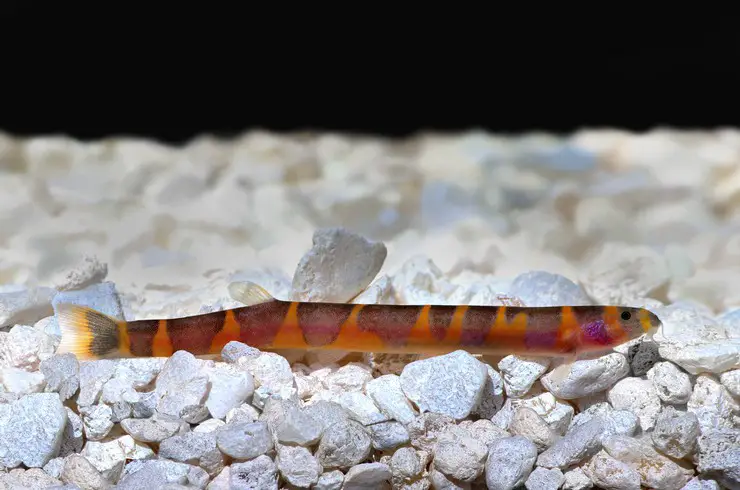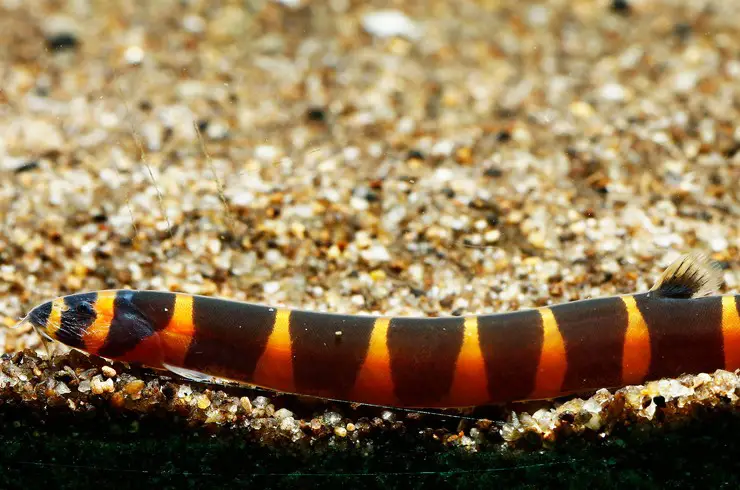Almost every aquarist sooner or later has a desire to have some interesting, unusual fish in his aquarium. The choice often falls on acanthophthalmus – amazing peace-loving loaches. Why are these creatures unique, we will consider in our article.
General information
Acanthophthalmus (Pangio sp.) Are representatives of a small family of Loach fish. A distinctive feature of these aquatic organisms is an elongated, serpentine body, which outwardly makes them look little like fish.
The second name of acanthophthalmus is thorn-eyes. Under the organs of vision, they have movable, backward-curved thorns that perform several useful functions. First, they allow the fish to squeeze through a very narrow space, clinging to various objects, plants and pulling the body along. Secondly, they serve as a good means of protection from predators: when trying to grab a loach, the thorns protrude and stick into the mouth of the attacker. Usually, this is enough for the fish to spit out such unpleasant prey and no longer make attempts to eat acanthophthalmus. The same predators that managed to swallow the loach completely, in most cases, die from rupture of the digestive system. These same spines create the illusion of a lack of an eye contour, for which the fish got its name “acanthophthalmus”, which literally translates as “torn eye”.
Acanthophthalmus, like other members of the family, is characterized by intestinal respiration: fish are able to swallow air bubbles, which, when they enter certain parts of the intestine, saturate the blood with oxygen.
And the striped snake fish are real living barometers. They are very sensitive to changes in atmospheric pressure, moving at great speed throughout the aquarium. Similar behavior is observed with deteriorating water quality. Thus, the fish shows that it is uncomfortable.
Appearance
Acanthophthalmus is characterized by an elongated serpentine body, slightly flattened laterally in the tail region. The maximum size of the fish is 12 cm. The head is small, the mouth is lower. Near it, there are 3 pairs of sensitive antennae, with the help of which the fish finds its food. The fins are transparent and very small; the dorsal fins are displaced towards the tail. Small scales are located on the body. The eyes are covered with a leathery film, under them there are spines forked at the ends.
The body color is orange or reddish with wide dark stripes, the number of which can be up to 20 pieces. Females are larger than males, have a more convex abdomen, through which greenish eggs can be observed.
Habitat
The historical homeland of acanthophthalmus is Southeast Asia: they are widely found on the Indonesian islands of Sumatra, Kalimantan, Java. They live in the waters of Thailand, Singapore, Malaysia. Several species are found in India.
Acanthophthalmus do not like strong currents, therefore they prefer slow-flowing rivers and streams with a muddy bottom covered with a thick layer of fallen leaves.
Care and maintenance
Acanthophthalmus are very mobile fish, so it is best to keep them in spacious aquariums from 50 liters. A lid or coverslip is required as fish may accidentally jump out. You can use sand as soil, because Acanthophthalmuses love to bury themselves in it, looking for food. During the day, the fish prefer to hide in shelters, so it is advisable to place driftwood, grottoes, rhizomes in the aquarium. It is very important to provide clean water and stable environmental parameters, for which it is important to organize effective filtration and aeration. The current should not be strong. Since loaches are crepuscular fishes, bright lighting will be inappropriate, acanthophthalmus feel more comfortable under diffused, dim light. Once a week, it is necessary to make a water change (25-30% of the volume of the aquarium), while taking care that the fish are not accidentally sucked in by the stream of water when cleaning the soil.
You can plant species of plants that are unpretentious to lighting in the aquarium: elodea, hornwort, Vallisneria. Be sure to place a pistia or riccia on the surface of the aquarium – they will shade it from bright light.
Compatibility
Acantophthalmus are very peaceful fish and get along well with most of the calm species in the general aquarium. Excellent neighbors will be tetras, danios, rasbora, guppies, neons, scalars, catfish corridors. Conflicts do not arise with their relatives either, they live well in groups. Acanthophthalmus can be planted without fear in an aquarium with shrimps, these fish will not cause any harm to the crustaceans.
But there are also a number of fish that are not recommended to live with. First of all, these are large cichlids (akars, astronomies, cichlazomas) – these clever predators will probably try to eat with nimble “worms”. Goldfish, in the overwhelming majority, are fans of digging up the ground and can devour a gaping acanthophthalmus in the process. Territorial bottom fish (such as labeo) can also harm loaches.
Feeding acanthophthalmus
Acanthophthalmus are omnivorous fish. In nature, they feed on small worms, insects, and larvae found in the ground. Loaches do not disdain carrion and dead parts of living plants. Thus, there will be no difficulty in feeding the fish in the aquarium. Acanthus will be happy to feed themselves with a live bloodworm or tubule, invertebrates will not be saved even by the ability to burrow into the ground: the fish will literally get them out of the ground. However, feeding with live food is fraught with serious dangers – it is easy to introduce infection or parasites into the aquarium. Many aquarists feed the acanthophthalmus frozen food, which is much safer than live food, but this feeding is not balanced. In fact, fish get nothing but a lot of protein.
High-quality dry food, unlike the previous two, has a number of advantages: they are completely safe, balanced, convenient to use and store. Acanthophthalmus will eat any dry food without any questions, regardless of its shape. They will love both the slowly sinking Tetra Min flakes and the sinking Tetra Diskus pellets. The latter will additionally give the fish brightness due to natural color enhancers. If Acanthophthalmos live in a shared aquarium, care must be taken to ensure that the food is not completely eaten by neighbors.
The most convenient form of food for acanthophthalmus is a sinking tablet such as Tetra Wafer Mix. They quickly sink to the bottom and are available for eating for a long time. It is recommended to feed the loaches at night after turning off the lights. At this time, they are most active.
The diet of these fish should be 20% plant-based, so you can additionally feed them with foods high in spirulina. TetraPro Algae chips or Tetra Pleco SpirulinaWafers tablets can be used.
Acanthophthalmos are excellent aquarium orderlies: they collect the remains of food from the bottom, preventing it from decomposing. They will also not ignore the dead parts of living plants. Sometimes they are able to eat small snails.
Thus, providing acanthus with a complete diet in an aquarium is not at all a difficult task. It is enough to feed the fish once a day, in the evening. You should not allow overfeeding, because fish are prone to obesity. For the same reason, it will be useful to arrange for the fish one fasting day a week.
Reproduction and breeding
Unfortunately, the reproduction of acanthophthalmus is a laborious process that requires certain knowledge and skills from the aquarist. After all, spawning stimulation is almost impossible without hormonal injections.
The general scheme of the process is as follows. First, a spawning aquarium is prepared with soft and slightly acidic water. The water level in it should not exceed 15-20 cm. At the bottom, it is necessary to lay a net with a small cell, because the newly-made parents will not mind eating their own caviar.
Selected producers (5-6 individuals) are temporarily immobilized and chorionic gonadotropin is injected into them. At the end of the procedure, they are placed in a spawning container where the rut begins. Males nestle on females, stimulating their spawning. In one spawning, you can get up to 700 eggs, which pass through the net and fall to the bottom. After that, the producers are set aside, antifungal drugs are added to the water. The first larvae appear within 3-4 days. Starter feed – “live dust”. During the period of fry growth, the aquarium must be shaded, because the fish do not like bright light. At the age of a crescent, babies have their first age spots. The size of the monthly fry is about 2 cm, and they are able to eat already quite large food.

